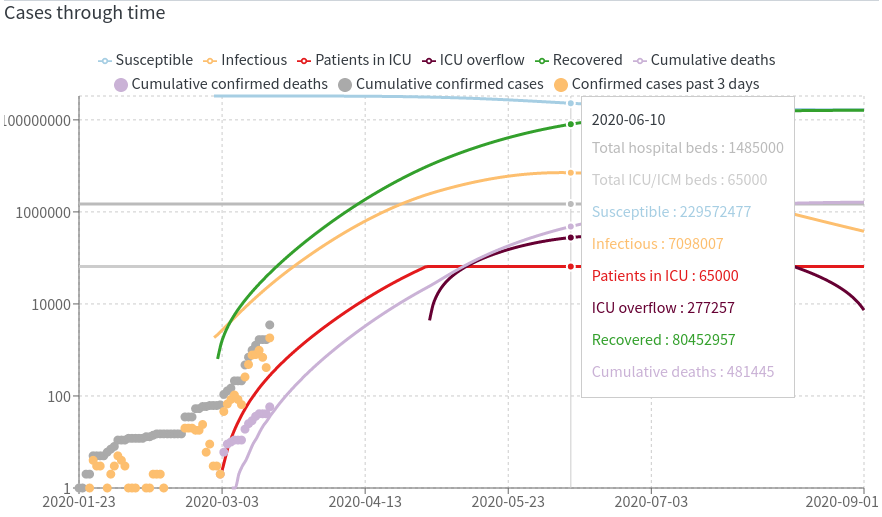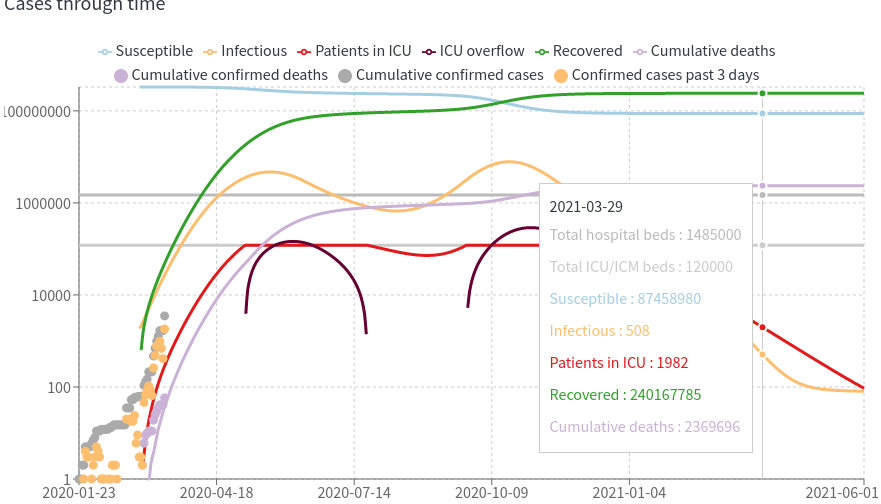As someone with asthma, when I had pneumonia in January 2020 it was fairly serious. I was home from work for two weeks, with a 105 fever and aches I couldn’t focus or work. The pneumonia was caused by Influenza B and I have to say, it is not something I wish to experience again. Around the time of my recovery, I also learned of COVID-19. We all have since learned of COVID-19 and long story short, this is a very serious situation.
We (the U.S. & world) have a choice between millions dead or tens of millions out of work for the next several years.
Unfortunately, the more infectious the virus, the longer and more extreme social distancing measures need to be in place. Eventually, this leads to a decision of life vs livelihood; when those converge, we can no longer “flatten the curve”. We have to return to work, regardless of the cost — we’ll be there soon.
COVID-19, Transmission
In January, it was very clear there was a potential issue and containment needed to enacted immediately.
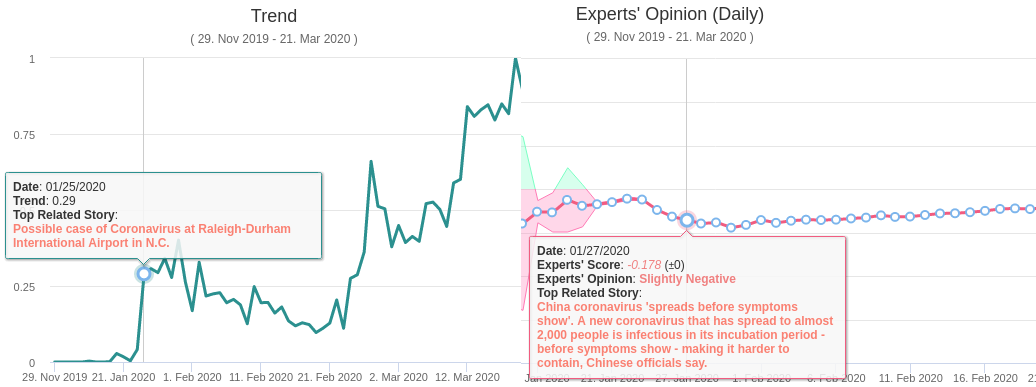
By early February, it was abundantly clear it was going to spread across the globe.
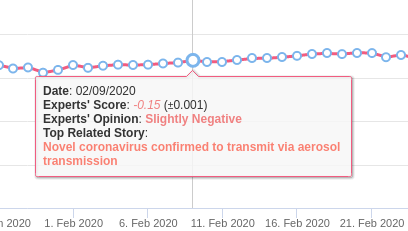
This was the pandemic scenario that everyone feared — highly contagious disease, novel disease, with above 1% fatality.
Once a virus can and regularly does transmit in an aerosol form, it’s insanely hard to contain and the CDC and the WHO were obviously aware of this.
In this particular case, asymptomatic patients can even transmit via an aerosol transmission. In way of a metric, SARS took 12-14 days to hit peak viral load[1], COVID-19 reaches peak viral load 5-6 days after symptom onset[2]. Further, asymptomatic patients can spread the disease, meaning there’s little reason they’ll be tested (and thus quarantined). There is also evidence that people can spread the disease prior to onset of symptoms:
Two patients under surveillance due to their exposure to patients with COVID-19 tested positive a day before symptom onset[2]
COVID-19, Fatality Rate
At this point, it is not clear what the fatality rate of COVID-19 will be. Best estimates are between 1% – 6%, with a functioning medical system. Unfortunately, there simply isn’t enough wide spread testing to get an accurate measurement. Further, this is only true while there is a functioning medical system… Without a functioning medical system, it’s likely to be higher (similar to what we saw in China – 6% or Italy – 8.5%, at time of writing).
We’ll cover medical system failure later on.
COVID-19, The Response
As mentioned, COVID-19 is easily transmitted and difficult to detect before transmission(s) can occur.
Still, China, Taiwan, Singapore and South Korea managed to contain the viral spread.
- China – where the outbreak occurred – had full city wide lock-downs for months. Sealed doors, indefinitely “quarantined” those who broke the lock-down, etc. Followed by heavy screenings, mask & gloves in public, tracing all cases and containing anyone who had contact with the virus.
- Singapore, South Korea, Taiwan – Heavy screening, masks & gloves in public, tracing all cases, light quarantines, published list of infected patients, etc.
I suspect (and experts tend to agree[3]) that because of their experience with SARS those countries were proactively looking for threats from disease. When found, the countries listed responded by screenings at the boarder and quarantining the sick. These populations were already prepped from SARS to wear masks and with the countries collective knowledge, they were able to act fast enough to contain the disease.
On the other hand, the United States, Italy, Germany, Iran, and all non-south-east Asian countries are not handling the outbreak as well. None of their populous has a recent experience dealing with a disease outbreak of this magnitude. Further, many denied there was a problem and / or weren’t proactive. This delay was enough for it to spiral out of control. Remember people are contagious before symptoms and peak around 5-6 days after symptoms appear, if they show symptoms at all.
This leaves only three responses:
- Do nothing, let millions die
- Lock-down everyone (China method), test everyone, clean everything. Once under control – trace and contain cases that pop up, loosen full lock down after a few months.
- Social distancing, shutdown all non-essential locations where people gather, reducing contact
Most countries in the west are currently (as of March 21st) are going the social distancing route.
COVID-19, Flattening the Curve
“Flattening the curve” describes reducing the number of infected patients at any one time, such that the medical system can keep up with the sick.
It appears the United States (and most of the world) at this point is practicing social distancing. Basically, we shut down all non-essential locations / job functions. This then reduces the rate of spread, in the hopes that it’s enough to keep the hospitals from being overwhelmed.
Unfortunately, at least in the United States, delays in testing led to reduced insight into spread. Thus, many measures were likely enacted too late and the scope of the illness is generally unknown.
In way of example, there’s a decent simulation by a research group at Biozentrum, University of Basel, Switzerland. While it’s likely not completely accurate (aka leaves a lot of room for interpretation), it does match many estimates I’ve seen / heard[4] (Michael Osterholm’s group suggests 96 million cases, 480,000 deaths over the next three to seven months.). Throughout the remainder of the post
This is the United States by June (and there’s little we can do):
The scary part, is that’s with heavy social distancing – meaning seeing 60% less people per day! Basically, only seeing your close family + shopping.
Say we then “loosen” up a bit in the fall, below is a graph of the number of normal interactions a day (100% being a normal day):
 Then right after the holidays, we’ll have a another spike:
Then right after the holidays, we’ll have a another spike:
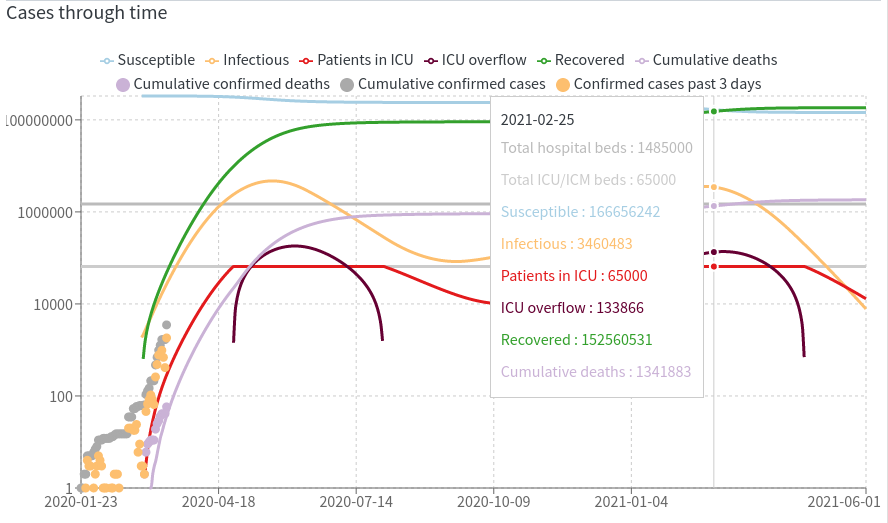 A second spike, just like the first spike, hundreds of thousands of deaths totaling somewhere around 1.5 million dead in the United States in one year from COVID-19.
A second spike, just like the first spike, hundreds of thousands of deaths totaling somewhere around 1.5 million dead in the United States in one year from COVID-19.
This is just a simulation. Perhaps, we’ll find a drug to mitigate the deaths; although our top advisor(s) the President seems a bit pessimistic[6]. Hopefully, we will also increase the number of ICU beds (and ventilators), as well as masks, gloves, etc. as time goes on.
Another (in my opinion more probable) route we can take is that in September 2020 we feel we finally have things under control, we have 120,000 ventilators (that’s double what we have in March 2020), masks have become more common so the spread is a bit slower. People start heading back to work, going to church, etc.
Unfortunately (per this simulation), that’ll cause a much larger second spike with 2.5 million deaths by the end of the year. We’ll realize our mistake, but not before it’s too late…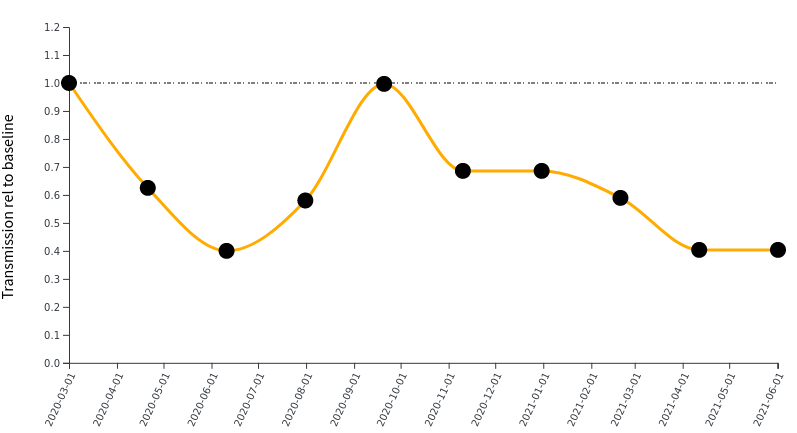
That’s the danger here. It’s going to be a long, multiple month journey of social distancing if we are actually going to limit the number of deaths.
COVID-19, Economic Impact
While all of this is ongoing and the social distancing is in place, what’s happening to the market?

This has been the largest drop since 1987, but more than that it’s continuing it’s downward trend. Goldman Sachs is predicting a massive downward swing in Q2, with a rebound in Q3.

However, as we discussed in the section above… if we really are going to not have millions of deaths, we’re going to have to “social distance” for months. Meaning we wont see airlines, restaurants, etc. returning any time soon. If we do, we’ll overwhelm the hospitals.
So… the options here are essentially four quarters of reduced GDP growth, with tens of millions out of work or millions dying. What curve are we trying to flatten? I’m confident our banks will be going belly up with a 50% default rate. Just in one month, they are down 46% on average:

Airlines are even worse, with virtually zero people flying (sorry to pick on United):

Even some of the proposed legislation offering a thousand dollars per family member is no where near enough to save the economy. Shutting down for a couple of weeks is one thing, but this is something else. We will need a prolonged shutdown of dinning in, limit travel, reduced factory output, etc. The government has a choice to make a large, strict, lock-down or a reduction in GDP (say 25% for the year), and at the end many companies wont survive.
COVID-19, The Conclusion
The idea of “flattening the curve” is a nice one and it will definitely save millions of lives here. With no mitigation in the US we’d likely see millions dead by August.
Ultimately though, we have to decide… JB Prizker, the govern of Illinois, yesterday (March 20) announced a “shelter-in-place” order, effectively urging people to stay home. During his announcement he said[7]:
I fully recognize I am choosing between saving people’s lives and saving people’s livelihoods, but ultimately you can’t have a livelihood if you don’t have a life.
The truth is, people also need sustenance and at some point he’s going to have to eat his words (I should add, I like how he’s handled this thus far… hopefully I wont eat mine).
The government cannot and will not fall to pieces, so my best guesstimate is that one million dead in the United States from COVID-19 by the end of the year (assuming we can get double the ventilators we have today). They will probably do some kind of staggered social distancing, combined with testing, perhaps temperature checks.
This will still lead to constant, but limited overflows at hospitals and should limit the damage significantly (while at the same time possibly letting us save industry).
 Honestly, even being in a high risk category (pneumonia a couple months ago + asthma). It would probably be better for all of us to rip off the band-aid as bad as that sounds. Even a staggered quarantine would kill the entire airline industry, putting millions out of work for over a year. There wont be much to come back to if this continues.
Honestly, even being in a high risk category (pneumonia a couple months ago + asthma). It would probably be better for all of us to rip off the band-aid as bad as that sounds. Even a staggered quarantine would kill the entire airline industry, putting millions out of work for over a year. There wont be much to come back to if this continues.
The way I like to think of it, if we had 3 million fatalities you might know someone who died of the disease (1/100). If this goes on long enough, we’ll all know many people who don’t have a job (1/3).
Ultimately, this virus is perfect to kill massive amounts of people and very hard to contain. It’s been shown you can contain it, but the west does not seem capable of doing so today, it’s spread too far. The more infectious the disease the longer the quarantine needs to take place — I don’t think our market can beat the virus.

